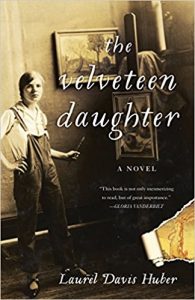Today I’m pleased to bring you an interview with the exceedingly talented Laurel Davis Huber, author of the fascinating biographical novel The Velveteen Daughter, about the lives of Margery and Pamela Bianco. I reviewed the book last week on its release date; you can find the review here.
 What inspired you to choose Margery and Pamela’s lives for the focus of your first book?
What inspired you to choose Margery and Pamela’s lives for the focus of your first book?
As so often happens in creative endeavors, serendipity was the inspiration. I was actually working on another novel but making little progress, so naturally I found every way to procrastinate. One June morning in 2006 I was getting nowhere in my writing. For solace I reached for one of my favorite books from childhood, an ABC book written and illustrated by someone named Pamela Bianco. As always, the illustrations entranced me—and on a whim I Googled Pamela’s name to see if she had written more books. Almost immediately I discovered that she had been a famous child prodigy artist. Well, that’s interesting…. I thought, and kept Googling. I found tiny bits of her story, mainly pieces of her art. Eventually, I came across a startling piece of information: her mother was Margery Williams, author of The Velveteen Rabbit. Wow! At that point I was certain that I had no choice but to ditch Novel #1 and begin Novel #2, which became The Velveteen Daughter.
The Velveteen Rabbit is such a well-known childhood story – why do you think that the Biancos’ story has never been told?
I love this question because I have pondered it for years. The answer is: I have no idea. But I am glad no one did tell it earlier because it was so exciting to discover all the disparate pieces of the story and to be able to present it to the world for the first time. It’s understandable that Pamela has been forgotten, I suppose, as her fame was fleeting. But it is utterly mystifying that no one has written a biography of Margery, who wrote one of the most beloved, most enduring childhood classics of all time. (And one could not write a biography of Margery without discovering Pamela’s story, too – so go figure.)
How long did the book take to research and write?
The whole process took ten years. I began the research that June day in 2006 and did mainly research for the next few years (although I did do a lot of very bad early writing at the same time!). The next seven years were consumed by the joy and pain (about in equal measure!) of writing and rewriting—I wrote at least six completely different versions of the book before feeling I had finally done the very best I could do.
You mention the research as a “wonderful obsession” that required “years of research” in your endnotes/acknowledgments. How does one even begin going about the business of research on a topic that has not really been covered before, on the lives of such seemingly private people?
I could write a treatise on this fascinating subject. The internet is a vast resource, but it was always the case that every internet clue would lead directly to an infinite variety of “real world” clues. One example was when I found online an obscure book of poems by Robert Schlick (Pamela’s first husband) for sale on the site of a rare book dealer in California. The book itself didn’t interest me, particularly, but there was a notation by the seller that drew me in like a siren call: two papers were tucked into a back pocket, and both described the Harlem wedding of Pamela and Robert. I asked the bookseller if he would send me copies of these papers, and when they arrived I felt I had found the Holy Grail! I read first-hand anecdotal accounts of the “impromptu” wedding—I knew who was there and what they wore, and what music was played. Really, it doesn’t get better than that.

Why did you decide to write it as fiction, rather than a more traditional biography?
I can be brief on this one! I did attempt to write a dual biography of Pamela and Margery, but my imagination took off at every point and it didn’t take long for me to realize that I simply had to fill in the blanks, and that meant dramatizing the story.
What was the biggest surprise in your research? In your writing?
In the beginning my interest was only in Pamela. I loved her art and saw many of her later paintings and wondered how she had evolved, and how and why she had turned from her “real” art to writing and illustrating books. When I said earlier that “eventually” I found out that her mother was Margery Williams, the truth is that that revelation came almost two years into my research. So surely that moment was the biggest surprise of all! The biggest surprise in my writing was the immense learning curve. I had never written a novel, but for some strange reason I thought, “Oh, I can write a novel, no problem!” I can assure you that my first efforts were nowhere near ready for prime time.
Pamela’s work hangs in museums all over the world, yet I was unfamiliar with her prior to your book. Given the fame of her early works, the prestigious collectors her work attracted, and the famous mentors and friends she had throughout her life, why do you think she is not a more well-known artist?
I think there are several reasons. There is probably a sizable crowd of artists who were known to a wide audience in the beginning of the twentieth century, yet their names are meaningless today. So few can be counted in the rarified world of those who achieve lasting fame. Also, there was a quarter of a century hiatus in Pamela’s work—she faded into obscurity in her twenties and then had a brief burst of fame in middle age. Lastly, since art is subjective, and there must be legions of wildly talented artists whose work is never recognized, who is to say whether Pamela should or should not be counted among the most famous? I have no idea, but I’m glad I had the opportunity to rescue her from the dustbin of history.
Pamela’s art is in many museums, but unfortunately, it is not hanging on the walls. Her paintings and drawings are buried deep in museum archives. During my research I descended into vast basements, climbed on ladders, and pawed through files for the privilege of seeing Pamela’s work.
It has been said that there is a fine line between insanity and genius, particularly in the arts. What, if any, do you think the relationship is between the two?
Another intriguing question. So much has been written on the subject. We’ve all read about the Van Goghs, the Plaths, and Beethovens who battled terrible demons even as they created masterpieces. As for Pamela, it seems clear to me that the genius of this child prodigy was not born of madness, it sprang from some quite untroubled place. Her exquisite drawings, which she was producing from the age of four, were not the product of a mad mind. For her, to draw was to live. She was, by all accounts, a very happy, normal child. Still, who is to say what lurks beneath the surface? And could it be true that her later works were born of madness? Perhaps. But I would hesitate to make that statement. I do think that the fact that her latest paintings each took years to finish and were detailed in such a precise manner—she sometimes used a brush with one hair for the tiny lines!—could point to an overly obsessive (troubled?) nature. I don’t think insanity spawns genius (that is the wishful thinking of the talentless who feel that a mad persona lends credence to their “genius”) but that genius can spawn insanity. Sometimes, as with Pamela I believe, it is the work, the pureness of art itself, that has the power to keep the madness at bay.
For more information about The Velveteen Daughter and its incredible author, Laurel Davis Huber, please visit her website. And if you would like to see an example of Pamela’s art, which is quite amazing, please visit here.


 Jill-Elizabeth LinkedIn
Jill-Elizabeth LinkedIn



Leave a Reply